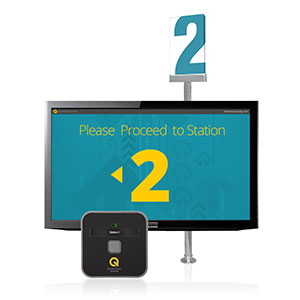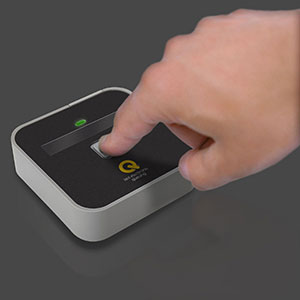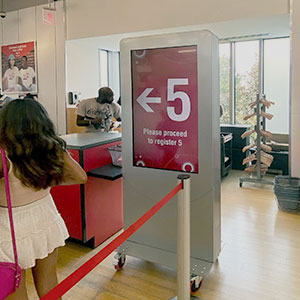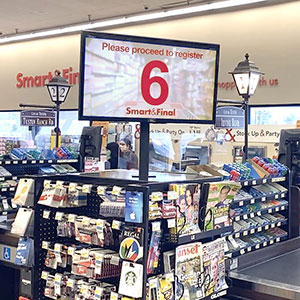
What is an electronic queuing system?
Electronic queuing is a wireless technology solution used to call waiting customers from a queue to a cashier or servicing station. Commonly used in venues where long lines are typical – such as airports, hospitals, stadiums, healthcare facilities, large retail shops, and banks – an electronic queuing system leads to faster service, helps prevent imbalanced wait times, reduces service agent down time, and boosts customer satisfaction. Also known as linear queue management systems, electronic queues can be set up quickly, are highly cost-effective, and can contribute to higher profitability.
Join us for an in-depth look at how electronic queuing works, the benefits across industries, and what you need to consider when setting up this type of system for your organization.

Dynamic features of electronic queue management systems:
To enhance customer service efficiency, electronic queue management systems come with:
- A small, portable computer equipped with queue management software
- A compact drive that provides wireless communication among all components
- One remote control per station to trigger numbers/arrows, audio, and visual displays
- HD digital display monitor with built-in audio capabilities to communicate with customers
- Pole lights stationed at the checkout registers, windows, or booths to attract attention from those on the queue
- Light controllers that enable wireless communication from the system computer, allowing pole lights to flash as needed

How do electronic queuing systems work?
State-of-the-art electronic queuing systems provide an organized, transparent and engaging approach to managing traffic flow. Here’s how they work:
- Each service station has a unique numbered remote control that when pressed by the staff member notifies waiting customers their station is now free to serve them.
- Upon pressing the button, the system guides the customer via directional arrows, register numbers, audible tones, voice messages (sometimes available in multiple languages) or a combination of these modalities.
- When several station buttons are pressed almost instantaneously, the system automatically prioritizes the queue order.
- To keep customers engaged while they wait in the queue, the system can be equipped to display/play promotional or informational media.

How electronic queue management benefits businesses and their customers
Long wait times spell trouble across every industry, impacting customer satisfaction and costing businesses significantly. One study revealed that 86% of U.S. consumers abandoned stores due to prolonged waits, resulting in $37.7 billion in annual lost sales for retailers. Speed is paramount, with two-thirds of consumers valuing it as much as price, and 50% becoming less likely to spend money with a business that makes them wait too long.
These findings underscore the need for technological solutions to expedite transactions and meet modern consumers’ expectations. Electronic queuing systems offer a solution to:
- Reduce wait time - improving customer throughput by up to 30%.
- Increase operational efficiency - diminishing staff down time waiting for customers to come to their station.
- Elevate the experience - delighting customers with speed, information, and entertainment.
- Boost sales - leveraging promotional media and strategic merchandising along the queue.
In any retail environment, Incorporating an electronic queue system allows customers to browse and shop while waiting, transforming what was an inconvenience into a fun, engaging experience that yields incremental revenue.

Advantages of electronic queue management over alternative queuing systems
Incorporating electronic queue management into businesses operating with linear queuing can significantly enhance operational efficiency and streamline service delivery. By integrating electronic queuing alongside existing stanchion-based waiting lines, businesses can expedite customer service and reduce wait times.
Additionally, electronic queuing systems offer built-in digital signage capabilities, allowing businesses to engage and inform customers effectively while they wait and promote products or services to a captive audience.

How is electronic queuing used across industries?
Electronic queue management is transforming operational efficiency and creating more positive and equitable waiting experiences across a wide spectrum of industries, including:
- Transportation: Airports, rental car operations, and customs and border patrol experience a daily influx of hundreds, if not thousands, of passengers. Electronic queues help to effectively manage and accelerate the flow, and more rapidly respond to sudden increases or decreases in line size.
- Hospitality & entertainment: From large stadiums and amusement parks to zoos and museums, electronic queuing systems allow staff members to focus on providing positive customer interactions, rather than directing traffic.
- Healthcare: Electronic queue management moves patients through checkpoints, while providing helpful information such as health bulletins and public service announcements.
- Retail: Electronic systems enable fast and fair queue management, boosting shoppers’ overall brand perception —and increasing brand loyalty.
- Finance: Banks, currency exchanges, and other in-person financial institutions use electronic queuing to expedite service through teller lines.
- Government: In environments from courthouses to passport offices to social services, electronic queue management systems help the public navigate large service areas. In turn, staff stress is reduced and service efficiency is improved.

What should organizations consider when implementing an electronic queue management system?
Working with an experienced and knowledgeable partner is paramount for successful implementation of an electronic queue system. In choosing a electronic queue management system, your partner should provide expert guidance on:
- Queue formation strategy: Which queue formation will best suit your customers— single-line, multiple-line or no-line (virtual)?
- Media strategy: What type of images and format (static vs video) will improve the customer experience — safety information, ads, or entertainment?
- Navigation strategy: What is the optimal placement of screens to engage customers?
- Notification strategy: What type of indicators are audiences most likely to respond to: flashing lights, audio, multilingual audio, or video?
- Merchandising strategy: How can the combination of queue set-up, digital media, and merchandise placement spur additional or impulse purchases to further drive revenue?
Partnering with an expert in electronic queuing, like Lavi Industries, can help to ensure that your electronic queuing system is a success for you, your staff, your customers – and your bottom line. With experience across virtually every industry with high volume queue needs and thousands of installations across the world, we can strategically guide you on customization, professionally implement your electronic queue system, and provide ongoing support as your needs evolve. Learn more.
SUSCRIBIRSE
Suscríbase para mantenerse al día con los nuevos productos, información y noticias sobre los recursos.
ENTRADAS DE BLOG RECIENTES
Theft at the Register: How Strategic Queue Design Protects Profits
Leer el artículo completoRapid Deployment Crowd Control: JetTrac Portable Barriers For The Biggest Spaces
Leer el artículo completo4 Psychological Reasons Your Customers Hate Waiting In Line
Leer el artículo completoFrom Bleachers To Bookstores: 4 Campus Crowd Control Solutions
Leer el artículo completo








